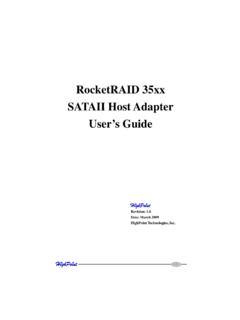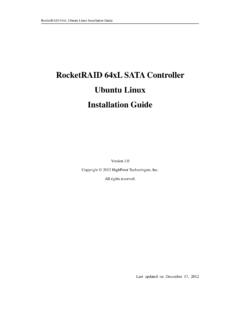Transcription of RocketRAID 2220 SATAII Host Adapter User’ s Guide
1 1 RocketRAID 2220 SATAII host Adapter User s Guide Revision: Date: March 2005 HighPoint Technologies, Inc. 2 Copyright Copyright 2005 HighPoint Technologies, Inc. This document contains materials protected by International Copyright Laws. All rights reserved. No part of this manual may be reproduced, transmitted or transcribed in any form and for any purpose without the express written permission of HighPoint Technologies, Inc. Trademarks Companies and products mentioned in this manual are for identification purpose only. Product names or brand names appearing in this manual may or may not be registered trademarks or copyrights of their respective owners. Backup your important data before using HighPoint's products and use at your own risk. In no event shall HighPoint be liable for any loss of profits, or for direct, indirect, special, incidental or consequential damages arising from any defect or error in HighPoint's products or manuals.
2 Information in this manual is subject to change without notice and does not represent a commitment on the part of HighPoint. Notice Reasonable effort has been made to ensure that the information in this manual is accurate. HighPoint assumes no liability for technical inaccuracies, typographical, or other errors contained herein. 3 Table of Contents TABLE OF ABOUT THIS INTRODUCING THE RocketRAID 2220 host Product UNDERSTANDING RAID CONCEPTS AND RocketRAID 2220 HARDWARE RocketRAID 2220 1 RocketRAID 2220 Adapter 2 - LED 3 - Installing the RocketRAID 2220 host 4 - Verifying 5 - Single-RAID Cross RocketRAID 2220 BIOS RocketRAID 2220 BIOS 1 - BIOS Command 2 - Creating RAID 3 - Adding/Removing Spare RocketRAID 2220 DRIVER AND SOFTWARE INSTALLATION MICROSOFT WINDOWS (2000, XP, 2003 SERVER)..17 WINDOWS DRIVER 1 - Installing the RAID Management Console/ Interface 2 - Software Interface - Overview of 4 3 - Creating an 4 - Deleting an 5 - Configuring Spare 6 - Recovering/Verifying 7 8 - Misc.
3 Array/Device 9 - Managing 10 - Configuring Remote 11 - Configuring Users and LINUX DRIVER Fedora Core 3 Linux installation Red Hat Enterprise 3 SuSE Linux Enterprise Server (SLES) installation CUSTOMER 5 About this Guide The RocketRAID 2220 SATAII host Adapter s User s Guide provides information about the functions and capabilities of the host Adapter , and instructions for installing, configuring and maintaining RAID arrays hosted by the Adapter . Introducing the RocketRAID 2220 host Adapter The HighPoint RocketRAID 2220 is an 8-channel Serial ATA II RAID controller. It utilizes a 64bit, 133 MHz PCI-X interface. The RocketRAID 2220 solution is aimed at enterprise storage applications, NAS storage, workgroup and web servers, video streaming / video editing workstations, back up, and security systems.
4 Product Features 8 Channels PCI-X to SATAII host Adapter Supports up to 8 SATA/ SATAII hard disk drives PCI-X 64-bit, 66/100/133 MHz PCI bus 64-bit LBA support for drive capacity over 2TB Supports RAID 0, 1, 5, 10, and JBOD Single RAID cross- Adapter (up to 16 disks per array) Supports Native Command Queuing (NCQ) Online Capacity Expansion (OCE) Online RAID Level Migration (ORLM) Staggered drive spin-up support monitoring of hard disk status for reliability SAF-TE Enclosure management Hot Swap and Hot Spare support Audible alarm LED support (disk activity and disk failure status) Quick and Background initialization for quick RAID configuration BIOS boot support Command Line Interface for RAID management (CLI) Graphical RAID Management Software (RAID Management Console) Automatic RAID rebuild SMTP support for email notification Windows 2000, XP, Server 2003, Linux and FreeBSD support 6 Understanding RAID Concepts and Terminology The following concepts and terminology is commonly used when describing the functions of the RocketRAID 2220 host Adapter .
5 Disk initialization Initializing a disk writes necessary RAID configuration information to that disk. Disks must be initialized before configuring them into RAID arrays. The initialization process will destroy all data on the disk. Disk Status New The disk contains no data and has not been initialized. Initialized The disk has been initialized and can be used for array creation. Configured The disk has been assigned to one or more arrays, or configured as a spare disk. Legacy The disk was used on other controllers before use with the RocketRAID 2220 (see legacy disk below). Array initialization A redundant array (RAID5, RAID1, RAID10) needs to be initialized to ensure full performance and reliability. Non-redundant arrays (RAID0, JBOD) do not need to be initialized. When you create a redundant array using the RocketRAID 2220 controller s BIOS Configuration Utility, it will create the array in un-initialized state.
6 The initialization process can be completed after installing the driver and management software. When creating an array using the HighPoint RAID Management Console software, you can specify an initialization option (Skip initialization, foreground and background). Foreground initialization Foreground initialization will zero-out all data on the array. The array is not accessible by the operating system until initialization is complete. Background initialization Background initialization allows the array to be used immediately. For RAID1 and RAID10 arrays, initialization will results in data being duplicated identically to the mirror pair. For RAID5 arrays, initialization will result in parity being generated from all array members. Note: An un-initialized RAID1 or RAID10 array can still provide redundancy in case of a disk failure.
7 A RAID5 array, however, is not fault-tolerant until initialization is finished. 7 Online Capacity Expansion (OCE) This feature allows disks to be added to existing RAID arrays, in order to increase the array s capacity, without fear of data loss. Any number of disks can be added to an array, at any time. Data can be accessed and utilized even while being redistributed. Online RAID Level Migration This term describes the ability to change one type of array (RAID level), into a different type of array (changing a RAID 1 array into a RAID 10 array for example). Data is still accessible during the migration process, and a base level of security is still active. OCE, OLRM and the RocketRAID 2220 The RocketRAID 2220 supports both Online Capacity Expansion (OCE), and Online RAID Level Migration (ORLM). Both features are supported by a single function - an array can be transformed from one RAID level to another RAID level while simultaneously being resized, even under I/O load.
8 Spare disk A spare disk is a single disk that can be used to automatically rebuild a redundant array in case of drive failure. Spare disks may also be members of a RAID array. Any available space on these disks may be used to rebuild other broken arrays. Legacy disk Disks attached to the RocketRAID 2220 that contain valid partition tables will be identified as legacy disks. A legacy disk attached to the RocketRAID 2220 can be accessed by the operating system, but cannot be used to create RAID arrays. A legacy disk must be initialized before assigning it to an array. 8 RocketRAID 2220 Hardware Description/Installation 9 RocketRAID 2220 Hardware 1 RocketRAID 2220 Adapter Layout Port1- Port8 These represent the RocketRAID 2220 s eight SATA channels. The SATA port furthest away from the surface of the Adapter is always the odd numbered channel (1, 3, 5, 7), while the port closest to the Adapter is the even numbered channel (2, 4, 6, 8).
9 CON1 - CON3 LED connectors (disk-activity/disk-failure): The RocketRAID 2220 does not utilize CON1. CON2 is for use with hard disk activity LED s, while CON3 provides disk failure LED support. LED support is discussed in greater detail in the LED Connection section (page 10), and in a separate document, the RocketRAID 2220 LED Guide (which discusses LED installation for specific server chassis, and will be available in downloadable form from our website). JP1 and JP2 These jumpers enable cross- Adapter RAID support. The RocketRAID 2220 includes a cable designed for use with these jumpers. Consult the Single-RAID Cross Adapter section (page 13) for more information. Speaker Alarm (speaker): the speaker emits and audible alarm in the case of disk/array failure. JP5 I C jumper/SAF-TE support: this support is dependent upon the system chassis.
10 Not all chassis models support SAF-TE features. Consult the chassis s manual for more information. 10 2 - LED Connections D1 through D8 represent SATA channels SATA1 through SATA8 respectively. The following diagrams describe the connector pin definitions for LED CON2 (disk activity), and CON3 (disk failure). CON1is not utilized by the RocketRAID 2220 . CON2: Hard Disk Activity (D1 through D8) CON3: Hard Disk Failure (D1 through D8) RocketRAID 2220 LED Guide For more information about LED support, and installation guides for various chassis configurations, consult the RocketRAID 2220 LED Guide . 11 3 - Installing the RocketRAID 2220 host Adapter Note: Make sure the system is powered-off before installing the RocketRAID 2220 host Adapter . The RocketRAID 2220 includes both standard and low-profile brackets.







